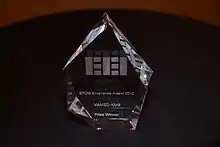EFQM Excellence Award
The EFQM Excellence Award is a transnational quality award that recognises European businesses with "excellent and sustainable results" across all areas of the EFQM Excellence Model.[1][2] It was established in October 1991 as the European Quality Award by the European Foundation for Quality Management (EFQM).[3] The assessment process is one of the most robust of any award, with a team of independent assessors spending an average of 500 hours per applicant reviewing documentation and conducting interviews on-site.[4]
| EFQM Global Excellence Award | |
|---|---|
 | |
| Awarded for | It recognises industry leaders with an indisputable track record of success in turning strategy into action and continuously improving their organisation's performance. |
| Sponsored by | EFQM |
| Location | Brussels, Belgium |
| Country | Europe |
| First awarded | 1992 |
| Website | www |
Award Categories
The Award is open to organisations from both the Private and Public Sectors. Applicants will either be recognized as "Finalists", "Prize Winners" or "Award Winners". An "Award Winner" is an organisation that is able to demonstrate that they are considered a role model for the Fundamental Concepts of Excellence, as defined in the EFQM Excellence Model.[5][6][7][8][9] There are 4 categories:
1. Large Private Sector (over 1000 employees)
2. Small / Medium Private Sector (less than 1000 employees)
3. Large Public Sector (over 1000 employees)
4. Small / Medium Public Sector (less than 1000 employees)
An independent jury of experts review the applications and the reports from the assessments. Each year, they can decide to give multiple awards, in line with the Award Categories. The last time there were multiple winners was 2008, when BMW won in the Large Private Sector category and St. Mary's College won in the Small / Medium Public Sector category. However, if no organisation can adequately demonstrate they are a role model, they can decide there is no Award Winner that year. This last happened in 2010.
References
- The EFQM excellence model: European and Dutch experiences with the EFQM approach in health care
- Vukomanovic, Mladen; Radujkovic, Mladen; Marija Nahod, Maja (2014). "EFQM excellence model as the TQM model of the construction industry of southeastern Europe". Journal of Civil Engineering and Management. 20: 70–81. doi:10.3846/13923730.2013.843582.
- Evans, James R; Lindsay, William M (1999), "4: Managing for Quality and High Performance", The Management and Control of Quality (4 ed.), Cincinnati, Ohio: South-Western College Publishing, pp. 143–144, ISBN 9780538882422, OCLC 38475486
- Sharjah Chamber of Commerce and Industry introduces the Sharjah Top 10 Business Award
- El madrileño Ayuntamiento de Alcobendas, nominado al EFQM Excellence Award 2016
- EFQM Excellence Award für BMW Regensburg
- Qatar Rail becomes full member of EFQM
- Emirates Group Security awarded the Dubai Quality Award
- Galway Bay Hotel wins prestigious EFQM Excellence award
